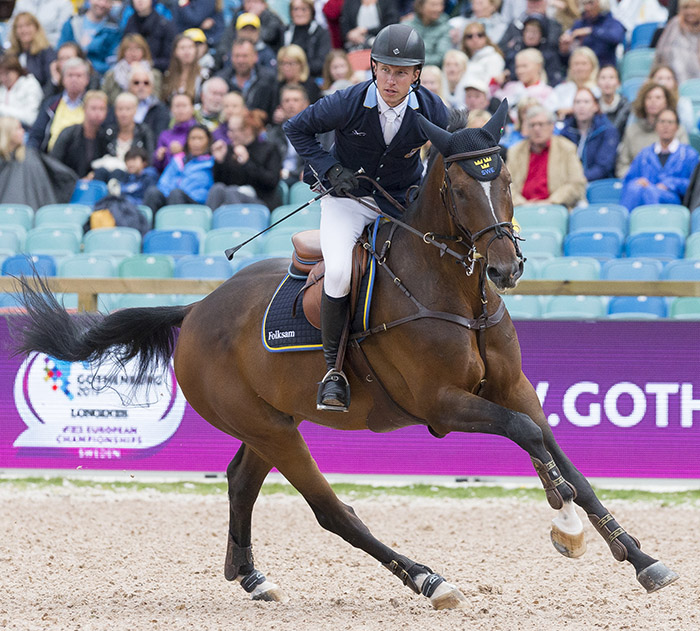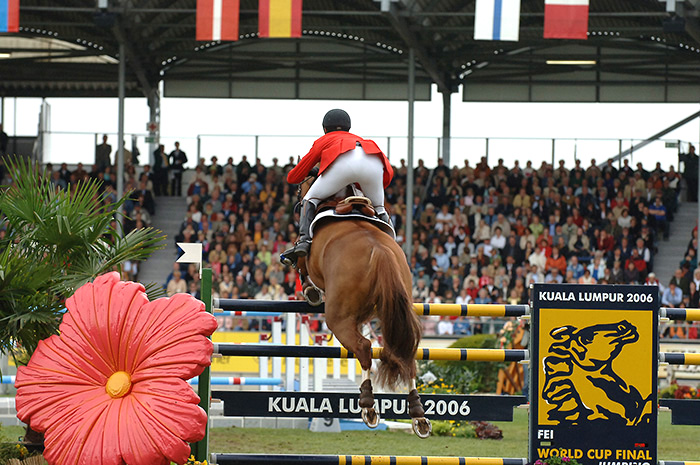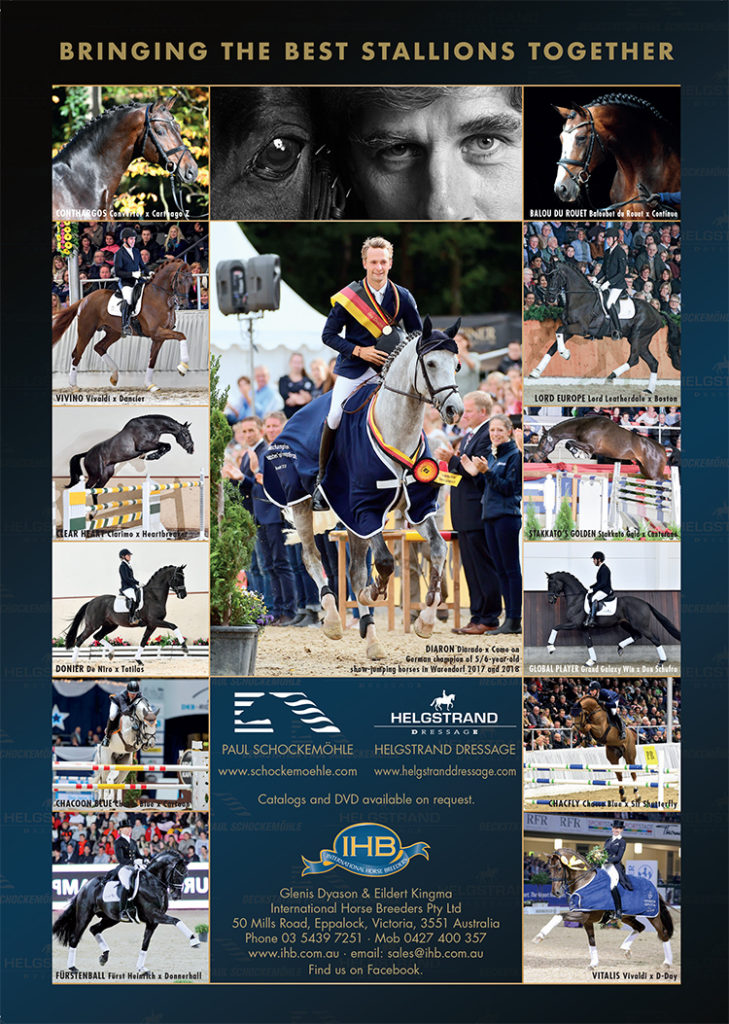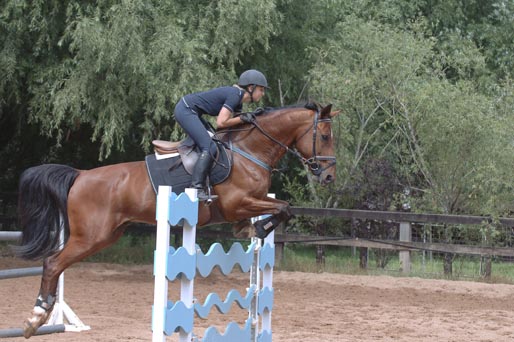We continue our jump-by-jump series and look at the ‘simplest’ of the showjumping obstacles, the vertical.
Missed part one? Here it is
According to George: “I think the first thing to understand about jumping any jump is that the jump is by and large an extension of the canter. If the canter is flat and long, then most likely, the jump will be flat and long. If the canter is short and bouncy, then he’s going to jump up in the air with not a lot of scope. That’s the first thing to get a grip on: if you are jumping verticals, your canter needs to be higher and more collected, shorter and higher to reflect the sort of jump you want to jump. If you are jumping an open water jump, which is the other extreme from the vertical, then you need ground speed and your canter must be close to a decent sort of galloping stride.”
“In between – on the ascending order, your vertical, the stile, planks on flat cups are the very very verticals. Then the verticals with substance, a wall or something with a very strong fill, that the horse will read better and back up more but the jump still needs to be ridden like a vertical. Then we’ve got narrow oxers ranging to wider and wider oxers, then triple bars – an ascending oxer where the horse can be longer and flatter and on to water jumps. That’s how we go from high and short to low and long.”

“Our canter has to reflect what sort of jump we are approaching. When we are jumping 80 or 90 centimetres, probably because the verticals are not that vertical and the oxers are not that wide, probably the same canter is going to do it for us pretty comfortably – but when we are jumping a metre twenty, thirty and bigger, then the difference in the type of jump has really got to be reflected in the canter.”
Story continues below the advertisement

What are the kind of problems that we encounter with verticals?
“It’s fair to say Australian horses have not got a history of jumping tall verticals very well. It’s partly because they are not so well schooled and partly because we ride Thoroughbreds, whose natural inclination is forward and long. Thoroughbreds are not physically and temperamentally set up to jump the verticals – with good training they can learn to jump them pretty well, but the Warmbloods with the higher knee action, hocks under them more naturally, and built more up in front, but still round, have the advantage. The Thoroughbred that is up in front is normally hollow, and if he is down in front then he is on the forehand. The Warmblood can be up in front and still round and carrying himself, so he is naturally better set up to do the job.”
“I think there is a training aspect to it as well, where Australian riders by and large don’t create the variety of canters that you need for the variety of jumps. That’s the less sophisticated riders, but I am sure that’s the same with less sophisticated riders all over the world.”
“The other major issue with verticals is that the distance is more critical, even though that sounds like it shouldn’t be the case, you would think that with a square oxer that is the same height as the vertical and has the spread element – you would think your distance would be more critical because the horse not only has to get his front legs off the front but he has to get to the back. But for a reason I have never discovered a good logical explanation for, horses do a far better job of reading the distance to an oxer than they do to a vertical. If you ride a moderately careful horse to an oxer, and you ride him forward to a deep distance, he will back up and rock back on his hocks, and get back off that front rail – whereas if you ride him exactly the same way to a vertical, he is more likely to run himself deep and hang his legs off it.”

“It has never been explained to me why this is so, and I’ve thought about it a lot. I have my take on that, which is that the horse looks at the totality of the fence, and the oxer creates more visual substance and backs him up more – just like a solid fence will back a horse up more than a very empty looking jump. The horse will do more to help you with the distance to the oxer than the vertical. In that respect there is a greater onus on the rider to create a very good distance to a vertical, especially a distance that is not too deep. The ideal way to ride a tall vertical is to ride with a very balanced, fairly active canter that is well connected, and ride him to a distance that gives him enough room to read the jump and get his front legs out of the way.”
Story continues below the advertisement

“The rider should be very balanced in his or her body for the same reason the horse backs off and organizes his jump better at the oxer than the vertical. The horse is more susceptible to lose his balance if the rider throws his body, or the rider does something unbalanced with his body. The whole balance is more fragile to the vertical than the oxer. The rider who throws his body, or throws the rein at the horse, he is much more likely to have the fence down, than if he rode an oxer the same way. The horse is not normally as well balanced to the vertical so it puts a greater onus on the rider.”
Are there gymnastics that you like to use to improve the horse’s ability to handle verticals?
“No, I’ not a gymnastic freak. I’m a big believer in ground lines for green horses. A nice comfortable ground line. You see people with ground lines that almost look like in and outs – I think that’s over the top. The reason a ground line helps a horse jump a vertical is that the green horse will normally get his height a little late. He thinks the jump is further away than it is, and he buries himself and then struggles to get his front end out of the road. What a ground line does is that it tricks the horse into believing that vertical plane of the jump is above where the ground line is, so he organizes his distance and his balance to the ground line, rather to where the jump really is, and that gives him more room – so he learns to jump the jump confidently without hitting it excessively and twisting and screwing himself out of the road. So he learns to rock himself and find his range to the verticals a lot better. I think ground lines are an important part of training young horses to jump good verticals.”
“Okay little gymnastics are terrific, but not to catch them out – not to have them hanging their legs all over the rails but to give them a comfortable space. A little bounce is good with a ground line. Little in and outs, they are fine: people think that a horse with a slow front end, that struggles with his verticals, they need to be put deep all the time, so they have to learn to be quick – but in my experience, if you pressure a horse’s weakness, you actually exacerbate the weakness. You’ve got to find a way for the horse to learn to do it in a comfortable way, so that the result is confident and solid.”
Next we look at oxers…




